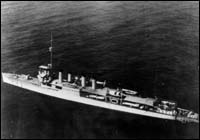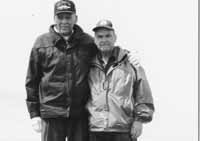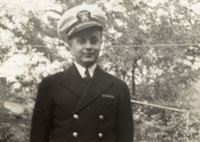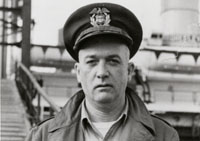Chapter 1: The Story – Dead Reckoning
Introduction
On February 18, 1942, the American naval vessels USS Truxtun, USS Pollux, and USS Wilkes were due to arrive at a large military base at Argentia, Newfoundland. Only the Wilkes made it. The other two ships went aground on the jagged rocks off Newfoundland's south coast in a ferocious winter storm. Giant waves pounded the vessels and eventually broke them to pieces. The Truxtun was trapped in Chambers Cove and the Pollux about one and a half miles west at Lawn Point. The Truxtun was carrying 156 men and the Pollux 233.
For hours, these men fought to survive in the driving sleet, howling wind, and bitter cold of the North Atlantic. With their ships breaking up beneath them, they first had to cross the raging ice-cold seas that separated them from land. Then they had to travel over miles of snowy wilderness to reach the nearest inhabited buildings. A great number of men spent all night outdoors, huddled wet and cold in caves or under clumps of trees. Many drowned or froze to death. Of the 389 officers and enlisted men on board the two vessels, 203 died.
But 186 lived. They survived because of their own determination, resourcefulness, and courage – and also because of the tremendous heroism displayed by the residents of St. Lawrence and Lawn who travelled to the wreck sites through blowing snow and spent hours hauling men out of the ocean, pulling them over icy cliffs, bringing them to a nearby mine, and then into their own homes. The rescuers and their families bathed the numb and semi-conscious survivors in warm water, gave them what little clothing and food they had, and nursed them back to health.
Although one of the worst disasters in United States naval history, the story of the Pollux and Truxtun is not just about death and anguish. It is about human courage, generosity, transcendence, and bonding. The local townspeople risked their own lives to save strangers in imminent danger and in the process forged intimate relationships that would not only span the decades, but would also dramatically change the lives of some survivors.
A striking example is Lanier Phillips, a black sailor aboard the Truxtun who was the victim of severe racism while growing up in Georgia during the 1920s and 30s, and also while enlisted in the US Navy. To this day, Phillips credits the kindness and respect he received from the white people of St. Lawrence with changing his life and giving him a newfound sense of self-worth. He says it motivated him to fight racial discrimination in the United States and to become the first black sonar technician in the US Navy. Today, Phillips is widely recognized as a civil rights role model. Although many lives were lost as a result of the two shipwrecks, 186 were saved, and at least one was changed for the better, with profound and far-reaching results.
Approaching the Coast
When the Second World War broke out in September 1939, Allied forces quickly recognized that Newfoundland was in an unusually strategic location. The island was closer to Europe than any other part of North America and an invasion there would give enemy forces easy access to both Canada and the United States. Yet the small British colony did not have any military bases of its own at the start of hostilities and could not afford to build any. As a result, the Newfoundland and British governments agreed to allow Canadian and American Armed Forces to establish a series of bases on the island and in Labrador. One of these was a large American air and naval base at Argentia, on the island's south coast.
On the night of February 17, 1942, the American supply ship Pollux was steaming toward this base with a valuable cargo of bombs, radio equipment, aircraft engines, and other supplies. It had left Maine two days earlier and was being escorted by the US destroyers Wilkes and Truxtun. These vessels would protect the Pollux in the event enemy attack. Many of the sailors in the convoy had enlisted in the Navy only two months earlier, following Japan's surprise attack against the US naval base at Pearl Harbor, Hawaii on December 7, 1941. The military strike prompted America to enter the war and motivated thousands of young recruits to join the armed forces.
By now, the Second World War was almost two and a half years old and the North Atlantic was a hotbed of military activity. German U-boats patrolled these waters and frequently torpedoed convoys travelling from one Allied port to another to prevent them from delivering equipment and supplies vital to the war effort. Just four months earlier, on October 31, 1941, a U-boat torpedoed the destroyer USS Reuben Janes as it steamed from Argentia to Iceland. The vessel sank within five minutes of the attack; of the 159 men onboard, only 44 survived.
In addition to worrying about enemy attack, however, sailors also had to deal with the unpredictable and hazardous weather conditions of the North Atlantic. A violent winter storm was pelting the Wilkes-Truxtun-Pollux convoy as it steamed toward Argentia. Visibility was zero and gale-force winds whipped sleet onto the ships' decks and covered them with ice. As the vessels plunged through giant waves and rough seas, navigation became a growing concern. Many men on board the Pollux worried they would collide with one of their two destroyer escorts. It was Navy policy that ships travelling in convoy follow a zigzag route. This helped to evade U-boat attack, but also increased the risk of collision in the blinding conditions of a winter storm.
Other factors also undermined the convoy's ability to plot a safe course. Navigators usually took star sightings to determine their exact position, but this was not possible when storm clouds obscured the night sky. Instead, the three vessels were navigating by a method known as dead reckoning – they used their last known positions to estimate their current location. Dead reckoning, however, is not entirely reliable because it does not take into account the effects of currents, winds, or human error on a ship's position. Unfortunately, all three of these were factors on the night of February 17, 1942.
The Wilkes was the convoy's flagship and therefore set the course the others had to follow. Its navigator, Lieutenant Arthur Barrett, plotted a dead-reckoning track from the star sightings he had taken at 6:23 that evening, before the clouds moved in. What Barrett didn't know, was that he had made a minor error while looking at the star Antares which had caused him to miscalculate the ship's position, placing it about two and a half miles south of its actual location. As a result, the Wilkes was now following – and leading two other vessels along – an incorrectly calculated course that was closer to shore than anyone realized.
Although Barrett's miscalculation was minor, it combined with other problems and oversights that night. The Wilkes was the only vessel in the convoy using radar, which was a new technology in 1942 and not as sophisticated as it is today. The model onboard the Wilkes had difficulties detecting land in icy conditions or stormy weather – both of which were present that night. Compounding the situation were the strong and unpredictable currents in Placentia Bay that pushed the ships close to land. Finally, new and inexperienced sailors were taking depth sounding aboard the Wilkes and did not recognize that their readings indicated the convoy was headed for dangerously shallow waters.
On board the Pollux, however, navigator Lieutenant William Grindley recognized the convoy was off course. He recommended to the ship's captain, Commander Hugh Turney, that they abandon the zigzag pattern and change course by 30 degrees. Turney was bound by Navy regulations to follow the track laid down by the flagship, but eventually agreed to a 10 degree course change at about 1:30 am on February 18. Unfortunately, this was not a large enough alteration to steer the ship out of a danger that lay just two and a half hours away.





